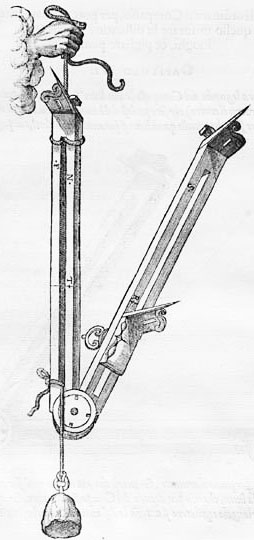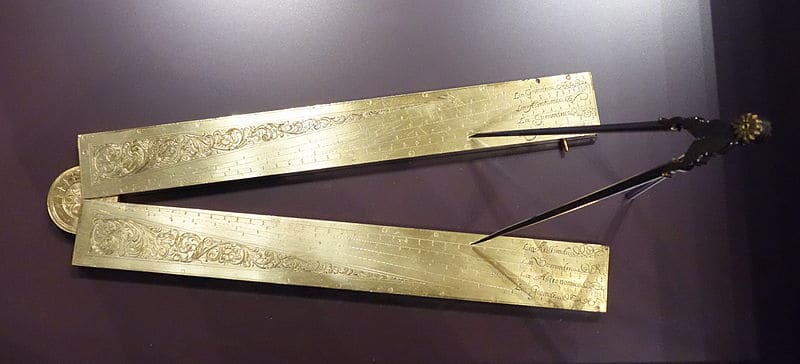
The Sector was a mathematical instrument invented around 1554. This device, which looked like two rulers hinged together on one end, allowed users to solve multiplication, division, proportion, and trigonometry problems as well mathematical functions such as cube roots and square roots.
Sector History
The Sector, also known as a “compass of proportion,” is a standard mathematical instrument that consists of two equal-length rulers linked by a hinge. Many attempts were made throughout the Renaissance to create a universal instrument that could be used to execute arithmetical calculations and geometric operations quickly. The Sector (like many other devices) was invented by several persons, virtually concurrently and independently, though it appears that the earliest was the Italian mathematician Fabrizio Mordente (1532-1608) about 1554.
Fabrizio Mordente was born in Salerno in 1532 and attended the Università di Napoli until 1552. He embarked on a ten-year journey throughout the world (Crete, Cyprus, Egypt, Palestine, Mesopotamia, India, Portugal, Ireland, England, France, Flanders, Germany, etc.). The idea of a proportional compass occurred to him during this voyage (he mentioned the year 1554), most likely due to his exposure to Indian and Arabic mathematics.
Mordente wrote a single page treatise devoted to Daniele Barbaro on the operation of a new compass, devised in 1554, in Venice in 1567 (Modo di trovare con l’astrolabio, o quadrante, o altro istromento, oltre gradi, intieri, I minuti, et secondi, et ognaltra particella).
Thomas Hood, a British mathematician who published a book about the device in 1598, is frequently credited with the invention or the Italian mathematician and astronomer Galileo Galilei. With the help of his instrument-maker Marc’Antonio Mazzoleni, Galileo created more than 100 copies of his military compass design and trained students in its use between 1595 and 1598. Galileo is undoubtedly the most famous of the credited inventors, and earlier studies usually attributed their invention to him.
In 1597 in England, Robert Beckit and Charles Whitwell made sectors independent of each other. Both of these devices resemble the device described in Hood’s book.
Mathematicians used sectors to perform calculations until the 19th century, when they were replaced by new tools, such as slide rules.
Sector: How It Worked
Different iterations of the instrument evolved into various shapes and added new functions. Mordente’s version of the device was a proportional compass with eight points that used sliding cursors to measure the lowest fraction of a degree. Based on their placements, it determined the proportions between lines, geometric shapes, and solid bodies. Hood’s model was designed to be used as a surveying instrument, and it had not just sights and a mounting socket for connecting the instrument to a pole or post but also an arc scale and an extra sliding leg. Galileo’s first models were meant to be used as gunner’s levels and calculating instruments.
The instrument is based on the principle of similar triangles and can be used to solve proportion questions graphically. A pair of jointed legs with paired geometrical scales is its most important feature. Problems are set up with a couple of dividers to establish the formal opening of the jointed legs. The result is taken off immediately as a dimension with the dividers. The original design was directly modified to include specialized scales for the area, volume, trigonometrical computations, and more straightforward arithmetical issues.
Although not all sectors are engraved with the same scales, they all share a line of lines scale. As the Sector grew to address various issues, it was impressed with multiple symbols. Two groups of scales can usually be identified. The first is real sector scales, which are twinned with one another. The origin of each leg is in the center of the hinge. Others placed on a sector for convenience will usually only be found as a single scale etched on one leg and a single scale engraved on the other leg. The hinge’s origin isn’t always in the middle.
The arithmetic lines refer to the instrument’s innermost scales, which are divided in arithmetical progression, that is, by equal additions up to the number 250. The geometric lines are the following scales, separated into 50 lengths that change as the square root of the labeled values. The stereometric lines get their name because their divisions are based on solid body ratios up to 148.
One of the applications of this scale is to compute the comparable edge of a similar solid body with a given volume ratio to the first when given one edge of any solid body. The Metallic lines had divisions on which the symbols (Italian abbreviations) denoting various minerals such as gold, silver, lead, marble, etc. These provide the weight ratios and variances of particular materials. The diameters of balls (or sides of other solid bodies) comparable to one another and equal in weight are indicated by the intervals between any similarly marked pair of points with the instrument set at any hole. The polygraphic lines calculate the circle radius that will contain the required regular polygon using the available information, including the side length and several sides. Tetragonic lines receive their name because they’re used to square all regular areas and circles. The added lines were employed with the other scales for various complex calculations.

©Daderot, Public domain, via Wikimedia Commons – Original / License
Sector: Historical Significance
A Sector is a tool that consists of two equal-length rulers connected by a hinge. The instrument is etched with many scales that aid in various mathematical calculations. It was used to solve proportion, multiplication and division, geometry, and trigonometry issues and compute mathematical functions like square roots and cube roots. Its various scales made it possible to solve difficulties in gunnery, surveying, and navigation in a simple and straightforward manner.
The name of the Sector comes from the fourth statement of Euclid’s sixth book, in which it is proven that similar triangles have proportional sides. Some sectors included a quadrant and, on occasion, a clamp at the end of one leg, allowing the device to be used as a gunner’s quadrant.
While the Sector appears to us to be nothing more than a ruler, its design was groundbreaking. It depicted measurement lines alongside ‘artificial lines’ such as sines, tangents, and logarithms. The Sector was a formidable tool when combined with an understanding of triangle proportions.
Sectors as Collector’s Items
Today, sectors are rare for several reasons. Many wooden sectors literally wore out from heavy use. Ivory sectors still exist, but America has restrictions on the sale of ivory that makes buying or selling them implausible.
You may be able to find a French or Italian brass sector to add to your collection. The price will vary based on its age, condition, and other factors, but be prepared to spend hundreds of dollars.